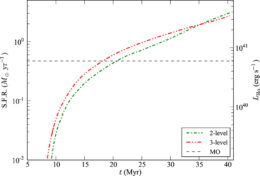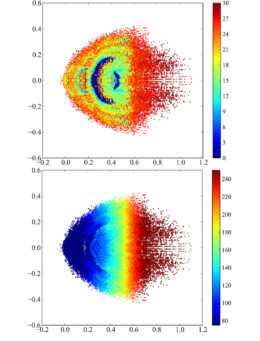What happens when the highly energetic jet from the center of an active galaxy rams into surrounding clouds of gas and dust? A new study explores whether this might be a way to form stars.

The authors’ simulations at an intermediate (top) and final (bottom) stage show the compression in the gas cloud as a jet (red) enters from the left. Undisturbed cloud material is shown in blue, whereas green corresponds to cold, compressed gas actively forming stars. [Fragile et al. 2017]
Impacts of Feedback
Correlation between properties of supermassive black holes and their host galaxies suggest that there is some means of communication between them. For this reason, we suspect that feedback from an active galactic nucleus (AGN) — in the form of jets, for instance — controls the size of the galaxy by influencing star formation. But how does this process work?
AGN feedback can be either negative or positive. In negative feedback, the gas necessary for forming stars is heated or dispersed by the jet, curbing or halting star formation. In positive feedback, jets propagate through the surrounding gas with energies high enough to create compression in the gas, but not so high that they heat it. The increased density can cause the gas to collapse, thereby triggering star formation.
In a recent study, a team of scientists led by Chris Fragile (College of Charleston) modeled what happens when an enormous AGN jet slams into a dwarf-galaxy-sized, inactive cloud of gas. In particular, the team explored the possibility of star-forming positive feedback — with the goal of reproducing recent observations of something called Minkowski’s Object, a stellar nursery located at the endpoint of a radio jet emitted from the active galaxy NGC 541.

The star formation rate in the simulated cloud increases dramatically as a result of the jet’s impact, reaching the rate currently observed for Minkowski’s Object’s within 20 million years. [Fragile et al. 2017]
Triggering Stellar Birth
Fragile and collaborators used a computational astrophysics code called Cosmos++ to produce three-dimensional hydrodynamic simulations of an AGN jet colliding with a spherical intergalactic cloud. They show that the collision triggers a series shocks that move through and around the cloud, condensing the gas and triggering runaway cooling instabilities that can lead to cloud clumps collapsing to form stars.
The authors are able to find a model in which the dramatic increase in the star formation rate matches that measured for Minkowski’s Object very well. In particular, the increased star formation occurs upstream of the bulk of the available H I gas, which is consistent with observations of Minkowski’s Object and implicates the jet’s interaction with the cloud as the cause.

The spatial distribution of particles tracing stars that formed as a result of the jet entering from the left, after 40 million years. Color tracks the particle age (in Myr) in the top panel and particle velocity (in km/s) in the bottom. [Adapted from Fragile et al. 2017]
Fragile and collaborators plan further refinements to their simulations, but they argue that the success of their model to reproduce observations of Minkowski’s Object are very promising. Positive feedback from AGN jets indeed appears to have an important impact on the surrounding environment.
Citation
P. Chris Fragile et al 2017 ApJ 850 171. doi:10.3847/1538-4357/aa95c6


1 Comment
Pingback: jets making stars